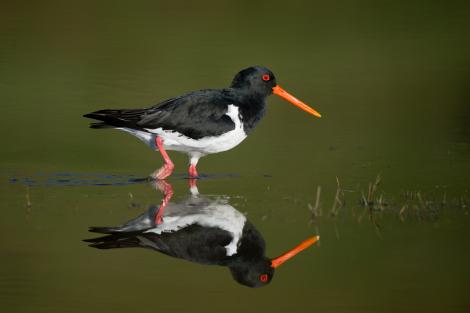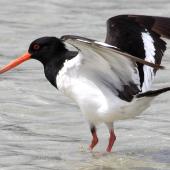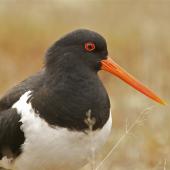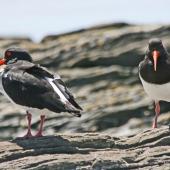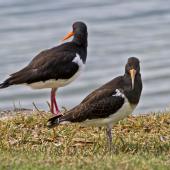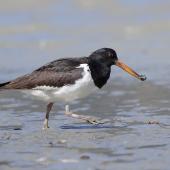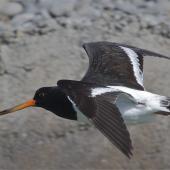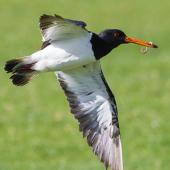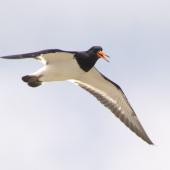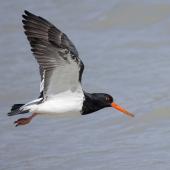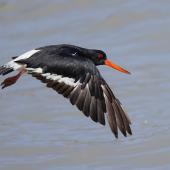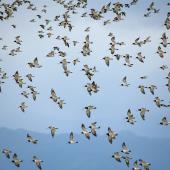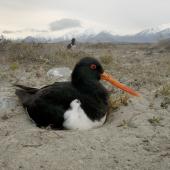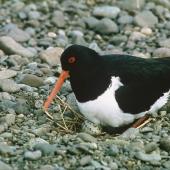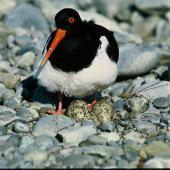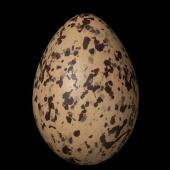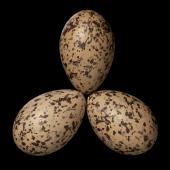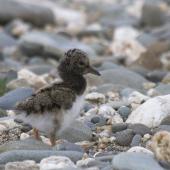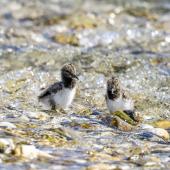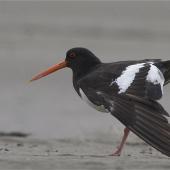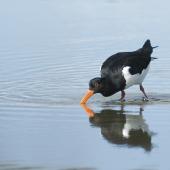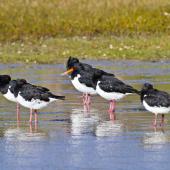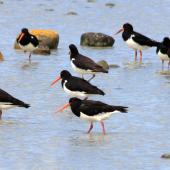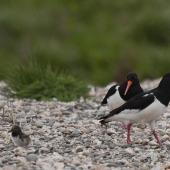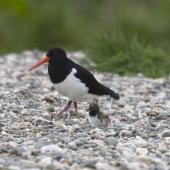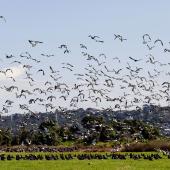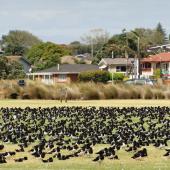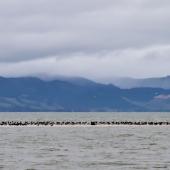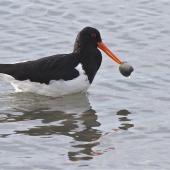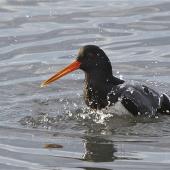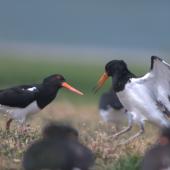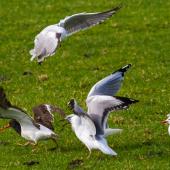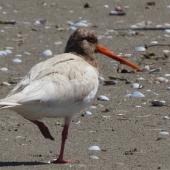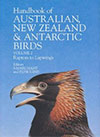South Island pied oystercatcher | Tōrea
Haematopus finschi Martens, 1897
Order: Charadriiformes
Family: Haematopodidae
Other names: New Zealand pied oystercatcher, Finsch's oystercatcher, torea, SIPO
Geographical variation: Nil
The South Island pied oystercatcher (SIPO) is the most abundant oystercatcher in New Zealand. The conspicuous black and white plumage and long red bill make this a familiar species. It is found on most estuaries, with numbers greatest during the period December to July. Fewer birds remain in coastal areas during the rest of the year, with most of the population moving to inland South Island riverbeds and farmland to breed.
Similar species of pied oystercatchers occur throughout Europe, North and South America and Australia.
Identification
The ‘SIPO’ is one of two species of oystercatcher on the New Zealand mainland. Solidly built, it is a striking black-and-white wader with a long, stout red bill and thick pink legs. There is a sharp border on the lower breast between the black upperparts and white underparts. In flight there is a white wingbar, rump and lower back. The sexes are similar. Juveniles have a brownish tinge to their plumage, dusky red bill and dull pink legs.
Voice: flight call a loud shrill “kleep”. Loud piping calls are given when defending breeding and feeding territories.
Similar species: can be confused with pied morph of variable oystercatcher, but the latter has a smudgy border on the chest and in flight has less extent of white, also with smudgy edges to rump and lower back.
Distribution and habitat
SIPOs occur throughout New Zealand in most estuaries and harbours. They usually breed inland in the South Island, mainly east of the Southern Alps on riverbeds and farmland, but are also known to breed on high country grasslands, and in coastal areas adjacent to estuaries and lagoons. Breeding has been attempted in Hawke’s Bay and southern Wairarapa since the 1980s. SIPOs migrate to coastal areas of both the North and South Islands after breeding. They have occurred as vagrants in Australia, New Caledonia and Vanuatu, and on Lord Howe, Norfolk, Kermadec, Chatham, Snares, Auckland and Campbell Islands.
Population
Total population estimated at 49,000 birds in 1970-71, but numbers increased subsequently and estimated at 112,000 birds in 1983-1994. More recent counts indicate that the total may have increased over the next several years, but has since declined to the 1988 level.
Threats and conservation
SIPOs have survived all the threats introduced to New Zealand during the past few centuries since the arrival of humans. These include the introduction of mammalian predators, hunting by humans (until 1940), and invasion of braided riverbed nesting areas by tall vegetation. Future abundance may now be threatened by land use changes in breeding areas, pollution of winter feeding areas, and increased disturbance to feeding and roosting birds at coastal sites.
Breeding
South Island pied oystercatcher breed in spring and summer. Nests are unlined scrapes on a mound or raised area of sand, gravel or soil with good visibility all around. Both members of the pair incubate the 1-3 eggs and care for the young. Incubation takes 24-28 days, and the young fledge 28-42 days after hatching. Most birds commence breeding when 3 years old.
Behaviour and ecology
Oystercatchers are strong fliers and have highly ritualised displays. On the ground they undertake loud piping displays to warn off other oystercatchers from feeding and breeding areas. Banded birds from one inland area in South Canterbury left their breeding territories during December-January and moved to coastal areas from Otago to Northland, with most individuals returning to the same estuary year after year. The pair bond is not maintained outside of the breeding season, although most birds retain their partner from one breeding season to the next. Banding shows that about 89% of adults survive from one year to the next, and so the oldest birds would live for about 25 years.
Food
In coastal areas SIPOs feed mainly on molluscs and worms, and have a strongly developed behaviour for preying on bivalves; other prey in coastal areas include crustaceans, cnidarians and fish. On wet pasture in coastal areas they feed mainly on earthworms and beetle larvae. There are no detailed studies of their food on their inland breeding areas.
Websites
References
Baker, A.J. 1969. The comparative biology of New Zealand oystercatchers. Unpub. M.Sc thesis, University of Canterbury, Christchurch, New Zealand.
Baker, A.J. 1973. Distribution and numbers of New Zealand oystercatchers. Notornis 20: 128-144.
Baker, A.J. 1974. Ecological and behavioural evidence for the systematic status of New Zealand oystercatchers (Charadriiformes: Haematopodidae). Life sciences contributions of the Royal Ontario Museum 96: 1-34.
Baker, A.J. 1974. Prey-specific feeding methods of New Zealand oystercatchers. Notornis 21: 219-233.
Heather, B.D.; Robertson, H.A. 1996. The field guide to the birds of New Zealand. Viking, Auckland.
Marchant, S.; Higgins, P.J. (eds) 1993. Handbook of Australian, New Zealand and Antarctic birds. Vol. 2, raptors to lapwings. Oxford University Press, Melbourne.
Sagar, P.M.; Barker, R.J.; Geddes, D. 2002. Survival of breeding Finsch’s oystercatchers (Haematopus finschi) on farmland in Canterbury, New Zealand. Notornis 49: 155-166.
Sagar, P.M.; Geddes, D. 1999. Dispersal of South Island pied oystercatchers (Haematopus ostralegus finschi) from an inland breeding area of New Zealand. Notornis 46: 89-100.
Sagar, P.M.; Geddes, D.; Banks, J.; Howden, P. 2000. Breeding of South Island pied oystercatchers (Haematopus ostralegus finschi) on farmland in mid Canterbury. Notornis 47: 71-81.
Sagar, P.M.; Shankar, U.; Brown, S. 1999. Numbers and distribution of waders in New Zealand, 1983-1994. Notornis 46: 1-49.
Recommended citation
Sagar, P.M. 2013 [updated 2023]. South Island pied oystercatcher | Tōrea. In Miskelly, C.M. (ed.) New Zealand Birds Online. www.nzbirdsonline.org.nz
South Island pied oystercatcher | Tōrea
- Social structure
- monogamous
- Breeding season
-
- Jul
- Aug
- Sep
- Oct
- Nov
- Dec
- Jan
- Feb
- Mar
- Apr
- May
- Jun
- Nest type
- scrape
- Nest height (mean)
- 0 m
- Maximum number of successful broods
- 1
- Clutch size (mean)
- 2.3
- Clutch size (min)
- 1
- Clutch size (max)
- 3
- Mean egg dimensions (length)
- 55.8 mm
- Mean egg dimensions (width)
- 38.6 mm
- Egg colour
- Brownish, blotched darker brown/black
- Egg laying dates
-
- Jul
- Aug
- Sep
- Oct
- Nov
- Dec
- Jan
- Feb
- Mar
- Apr
- May
- Jun
- Interval between eggs in a clutch
- 2 days
- Incubation behaviour
- shared
- Incubation length (mean)
- 24-28 days
- Nestling type
- precocial
- Age at fledging (mean)
- 28-42 days
- Age at fledging (min)
- 28 days
- Age at fledging (max)
- 42 days
- Age at independence (mean)
- 42-60 days
- Age at independence (min)
- 42 days
- Age at independence (max)
- 60 days
- Age at first breeding (typical)
- 3 years
- Maximum longevity
- 29.3 years
- Maximum dispersal
- 1000 km




